Authentic Scottish Dundee Cake
This post may contain affiliate links. See my disclosure policy.
A thoroughly authentic Scottish Dundee Cake recipe! Immediately recognizable by its trademark design of concentrically positioned almonds, this famous orange, raisin and almond cake is one of Scotland’s culinary treasures. Wonderfully flavorful and aromatic, it’s said to be Queen Elizabeth’s favorite cake for tea-time!
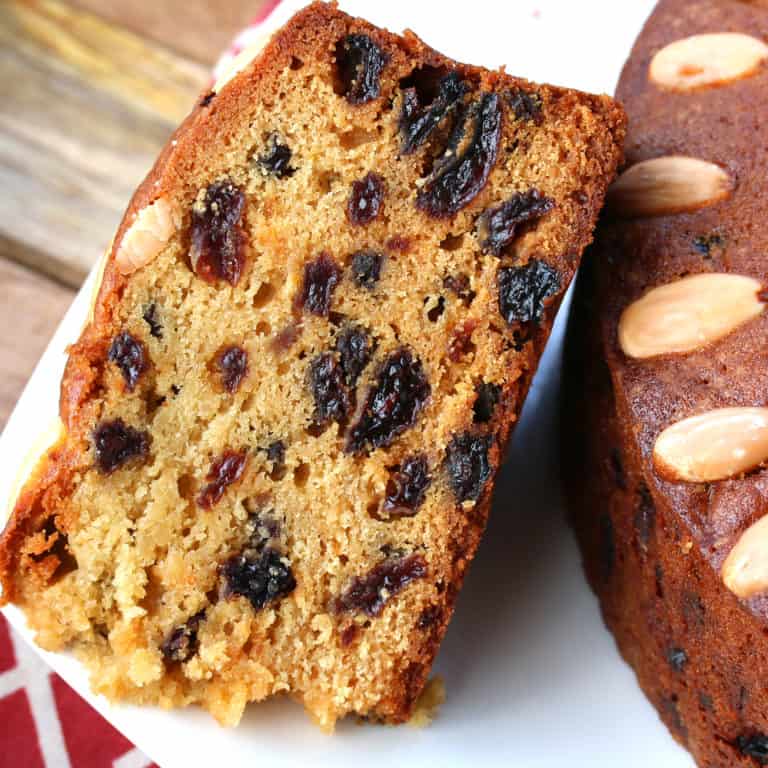
Will the REAL Scottish Dundee Cake Stand Up?
Everyone with glacé cherries sit down. Everyone with mixed spice or gingerbread spices have a seat as well. Anyone with whisky, brandy or rum sit down also…
There are endless varieties of Dundee Cake out there and the vast majority are imposters. But that holds true for many old, traditional dishes that someone somewhere decided to alter and over time the original ingredients became mingled with others until the version that became the most common no longer resembled the original version.
Is that always a bad thing? No. Variations on traditional recipes taste perfectly good. They’re just not…traditional. They’re not the real deal.
In the case of Scottish Dundee Cake the vast majority of the recipes out there are really just an English fruit cake with the almonds across the top to make it “look” like a Dundee cake. But the traditional version of Scotland’s prized Dundee cake is something quite different.
Authentic Scottish Dundee Cake
Besides the flour, butter, sugar, eggs, baking powder and touch of salt, the only other ingredients in an authentic Dundee cake are raisins and/or sultanas, orange zest, almonds, and Seville marmalade. That means no other dried fruits or nuts, not glacé cherries, no gingerbread or other spices, and no whiskey, brandy or rum.
What sets Dundee Cake apart from any others is its featured flavor: Orange. And not just any orange, specifically the sweet-bitter Seville orange with its own unique and characteristic flavor. All of the other ingredients serve to support that flavor and not take away from or dilute it.
What we have in a true Dundee cake is a much lighter and delicately flavored cake that showcases that Seville orange flavor along with the added sweetness of raisins and sultanas, and the additional flavor and delightful crunch of almonds. A true Scottish Dundee Cake hasn’t been altered to taste like the mainstream fruit cakes we all know, instead it has a very unique flavor all to its own.
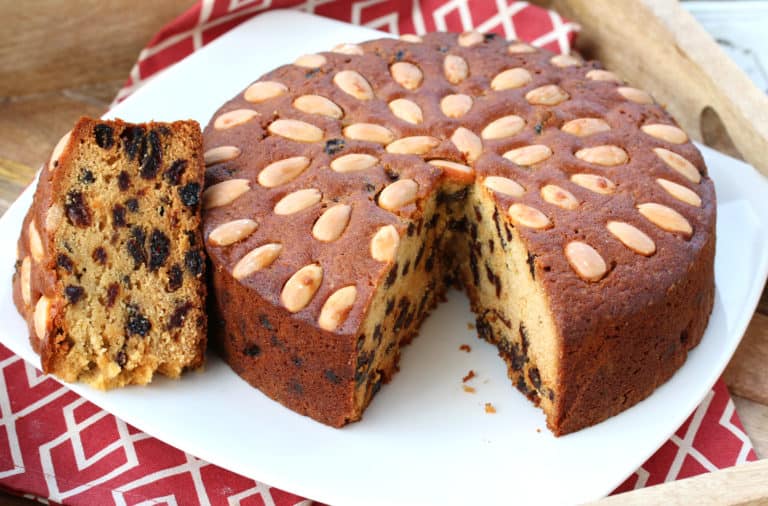
The History of Dundee Cake
There are some varying accounts but food historians believe that the Dundee cake dates back to the 1600’s and is attributed to Mary Queen of Scots (who incidentally is my great+ grandmother on my father’s side. I used to think all of my royal connections made me special until I found out that virtually everybody with European ancestry has royal lines once you get back to a certain point. So depending on how you choose to look at it, that means we’re either all special together or that nobody is special since we’re all…uh…special). In any case, Mary apparently hated glacé cherries (something I inherited from her) and wasn’t fond of the traditional fruit cakes either (same here, unless I’m using homemade candied citrus peel).
So her royal cook made her a cake that simply had raisins/sultanas and almonds in it but also featured a very unique ingredient that would forever set the Dundee cake apart from any other. It featured the subtle but striking flavor of Seville oranges that were being imported into the Scottish port town of Dundee via Spanish merchants sailing up from Spain. The original cake also used Spanish sultanas and almonds. Evidently she liked it because the cook lived to make many more and the cake soon made history.

Fast forward to the 18th century: The Keiller Marmalade Factory in Scotland started making Seville orange marmalade and marketed it in conjunction with the Dundee cake. Ever since then, instead of using Seville orange peel the Dundee cake has been made with Seville orange marmalade. This not only makes Seville oranges more accessible during off season and in other parts of the world, it also contributes the extra sweetness to the otherwise bitter oranges.
Some historians have wondered if it was in fact the Keiller Marmalade Factory who created the first Dundee cake instead of Mary Queen of Scots’ cook. But what we do know for certain is that the credit of using of the Seville orange marmalade goes to Keiller and it may also be that Keiller created the striking and instantly recognizable design of the concentric rings of whole blanched almonds on top of the cake which also add an positively delightful “crunch”.
By the 19th century the Dundee cake became popular throughout the tea rooms of Great Britain and was the dessert of choice for tea-time for both Winston Churchill and Queen Elizabeth II.
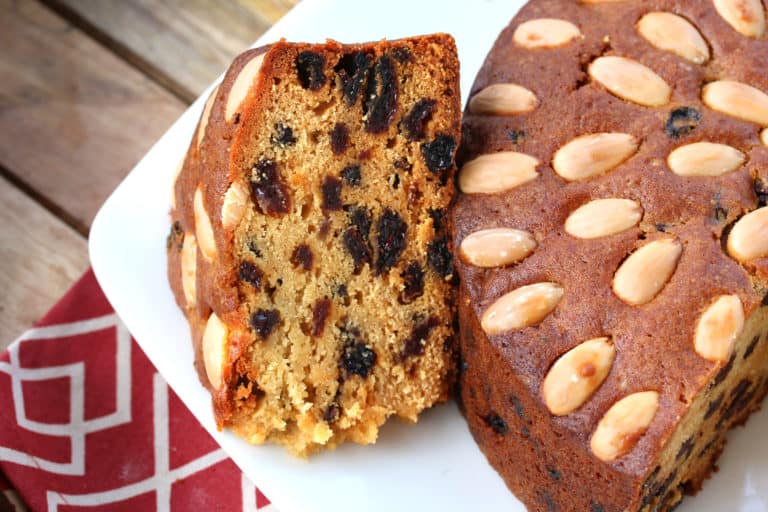
Authentic Dundee Cake Recipe
Let’s get started!
Be sure to use Seville orange marmalade for an authentic-tasting Dundee cake. I brought a few jars back with me from our trip to Scotland last year. I’ve seen Mackay’s Dundee Orange Marmalade at World Market, in some large grocery chain stores (e.g., Albertson’s), speciality stores, and you can find Mackay’s Dundee Orange Marmalade on Amazon. You can also find the original Keiller Orange Marmalade on Amazon. Note, there are other brands of Seville orange marmalade, just pick a good one because they are not all of equal quality.
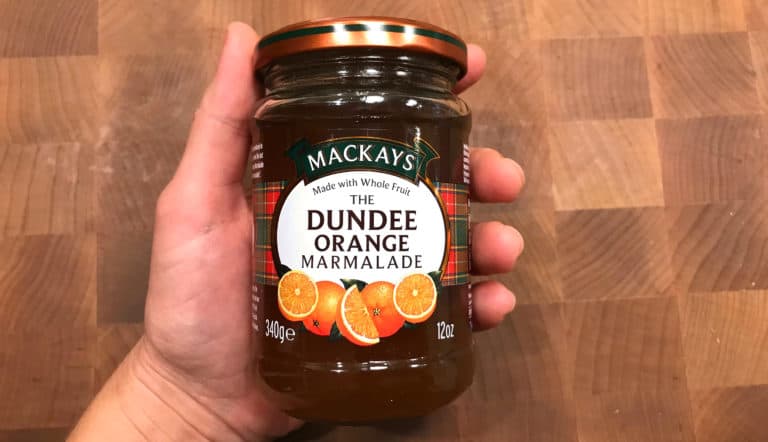
Cream the sugar and butter until pale and fluffy.

Add the eggs, one at a time, along with a teaspoon or so of the flour to prevent curdling.
Add the orange zest and marmalade and beat until combined.
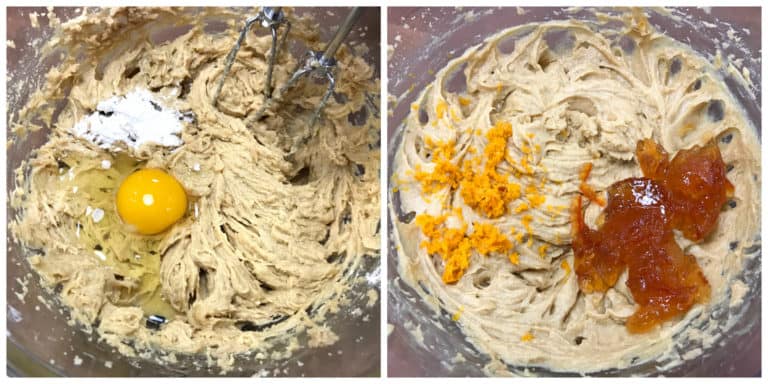
Stir together the flour, baking powder, and salt and almond flour. Add this mixture to the wet mixture and stir gently to combine, being careful not to over-stir.
Add the sultanas and raisins and stir to combine.

Grease and line an 8×3 inch round cake pan (alternatively a 9 inch round cake pan).
Spoon the batter into the prepared cake pan.
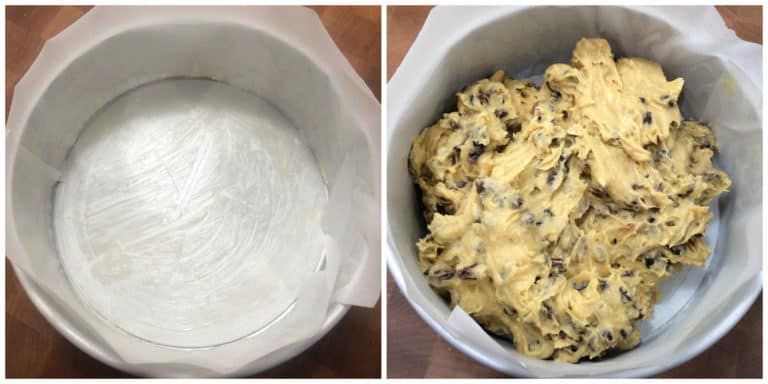
Smooth the top of it using wetted fingertips or the back of a wet spoon.
You’ll need roughly 20 whole blanched almonds for the top. See the “note” in the recipe box for directions on how to blanch the almonds (ie, remove the peels).
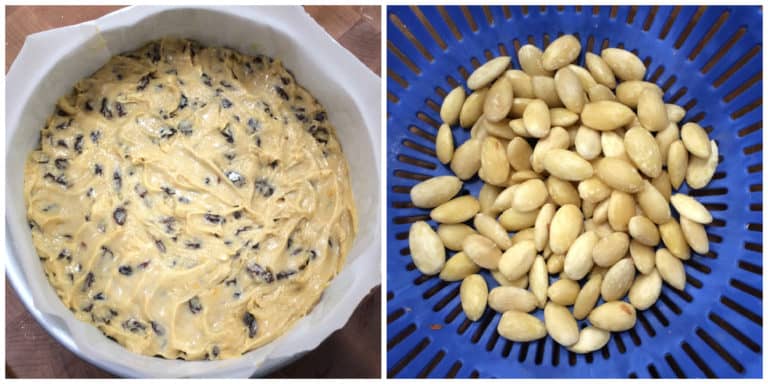
Preheat the oven to 300 F.
Arrange the almonds on top of the cake in concentric circles. Position the cake on the middle rack of the oven and bake for 100-120 minutes or until a toothpick inserted into the center comes out clean. If the cake browns too quickly cover it with aluminum foil.
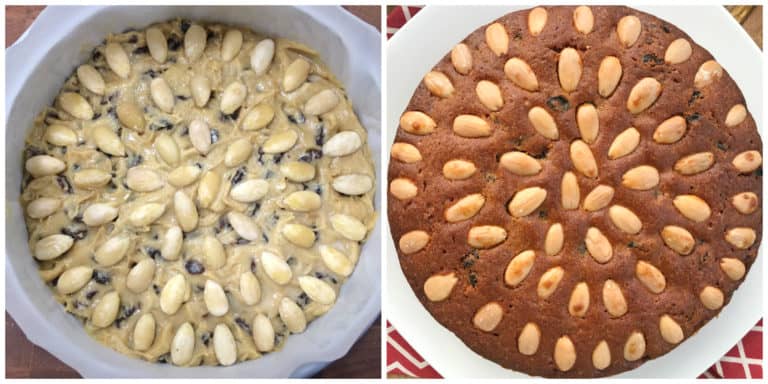
Let the cake cool in the pan for about 10 minutes.
Remove it from the pan and place it on a wire rack to cool completely.
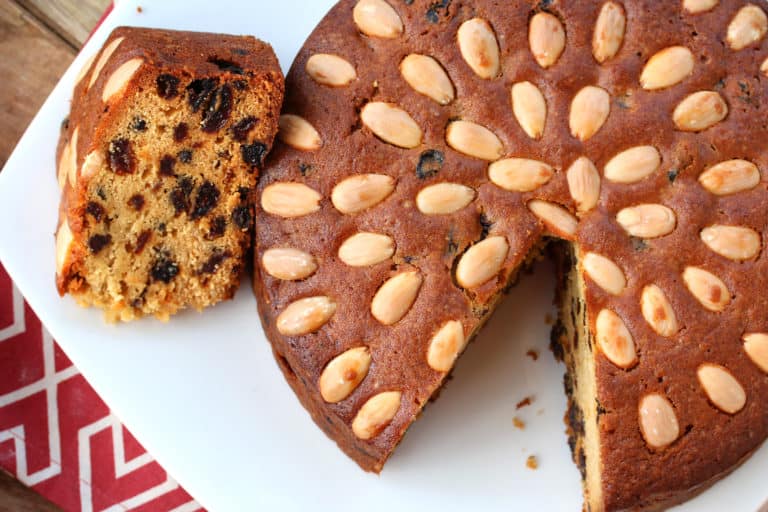
Storage and Freezing
Store the cake in an airtight tin at room temperature. To ensure it stays moist you can wrap it and then put it in the tin. It will keep for about a week.
Dundee cake can also be frozen. Wrap it well and store it in a freezer-safe container or freezer bag and it will keep fro up to 3 months. Let it thaw at room temperature.
Enjoy!
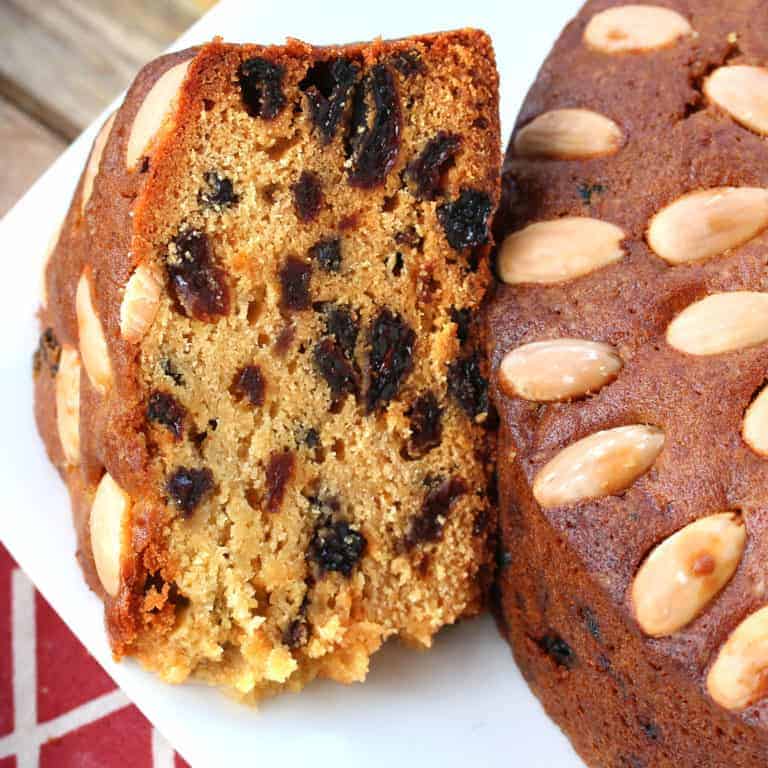
For more traditional Scottish recipes be sure to try my:
Save This Recipe
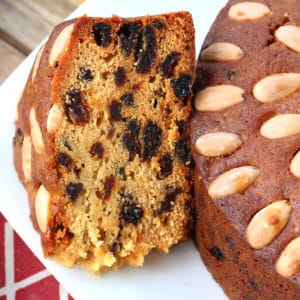
Authentic Scottish Dundee Cake
Ingredients
- 3/4 cup unsalted butter , softened at room temperature
- 1 cup firmly packed light brown sugar
- 3 large eggs
- zest of one orange (Seville if you have it)
- 5 tablespoons Seville orange marmalade
- 1 1/2 cups all-purpose flour
- 1 teaspoon baking powder
- 1/2 teaspoon salt
- 1/3 cup almond flour
- 1 1/4 cups golden raisins/sultanas (dried white grapes)
- 1 1/4 cups raisins
- 20-25 whole blanched almonds (See Note about blanching almonds yourself)
Instructions
- Grease and line a 8×3 inch round cake pan (alternatively a 9 inch round cake pan). Preheat the oven to 300 degrees F (275 F if using convection).
- Cream the sugar and butter until pale and fluffy. Add the eggs, one at a time, along with a teaspoon or so of the flour to prevent curdling. Add the orange zest and marmalade and beat until combined. Stir together the flour, baking powder, and salt and almond flour. Add this mixture to the wet mixture and stir gently to combine, being careful not to over-stir. Add the sultanas and raisins and stir to combine.
- Spoon the batter into the prepared cake pan and smooth the top of it using wetted fingertips or the back of a wet spoon. Arrange the almonds on top of the cake in concentric circles.Position the cake on the middle rack of the oven and bake for 100-120 minutes or until a toothpick inserted into the center comes out clean. If the cake browns too quickly cover it with aluminum foil. Let the cake cool in the pan for about 10 minutes before transferring it to a wire rack to cool completely.
Notes
Nutrition
Originally published on The Daring Gourmet November 25, 2019



















Hi, I would like to ask you could keep this cake till Christmas? I made today 2 for a gift.
Hi Katalin, no it will not keep that long; it won’t keep any longer than a standard cake. It’s not like a fruit cake made with rum; there’s no alcohol in it to help preserve and extend its shelf life.
I feed my Dundee Cake with Brandy , a wine glass full once a week and it’ll keep ’til and beyond Christmas, but it will darken the cake. Still scrummy though.
This is what I want to do as a gift for a friend. Do you refrigerate it the whole time? He said he’s used to this with whiskey. Has anyone done this? I assume you poke it with a toothpick and pour in the alcohol, then repeat for several weeks? Thoughts anyone?
I used to make two Dundee cakes before returning to boarding school. When the school food, good quality but not enough for a growing lad, I used to go down into the cellar where our tuck boxes where stored and help myself to a slice of my Dundee cakes. Filled the hole in the stomach nicely!
Dr Magnus Pyke said that fruit cake was ideal for growing boys, and I’m glad my mum took him at his word. I was welcomed home from a cycle tour with a Dundee cake, and overhead her phone-call to my grandmother mentioning the cake disappearing within a couple of days.
You and Harry P have a lot in common. Bad boys.
Made this recipe in a springform pan with central tube. It baked perfectly in one hour and forty minutes. Delcious, buttery, tangy (with the Seville rind) and rich, rich, rich. The perfect cake to have with your afternoon cup of tea.
Wonderful, Alexa, I’m so glad you enjoyed it, thank you! Yes, it is indeed the perfect cake for afternoon tea.
ooh, thanks for that – I love the idea of using the tube pan.
The recipe sounds wonderful. I didn’t see when you add the almonds…..I guess just before the cake goes into the he oven. Thank you
Hi Julie, sorry for the confusion – yes that’s correct, arrange the almonds on top of the cake just before baking.
If one lives where authentic Seville orange marmalade is not available (I don’t do mail order), can home made marmalade or candied orange peel (home made) be substituted? And, if using candied peel, how would you adjust for the sweetening and moisture of the marmalade?
Hi Freyda, you can also use regular orange marmalade/preserves/jam if you can’t find Seville. If you’re instead using candied orange peel I would aim for 3-4 ounces and you can add a couple of extra tablespoons of brown sugar if you like. For some additional moisture content two tablespoons of milk should do the trick.
Never heard of this before but it looks fantastic! Cant wait to give it a try
I have always heard of this recipe, but haven’t ever given it a try! Looks too good to pass up, indeed!
Mmm looks so yummy! Can’t wait to try it